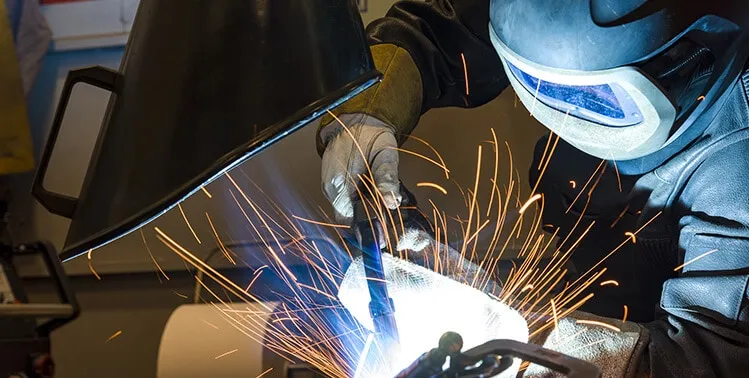By now you probably know about welding fume health risks and how to reduce them. You might also be aware of the variety of fume extractors available, such as the portable welding fume extractor (PHV) or the heavy-duty mobile fume extractor (MobilePro), to stationary fume extractors.
But how do I choose the right fume extraction system? This guide will help get you started on your journey to enjoying clean air at work!
If you know how many hours a day you weld or grind and would like a hassle-free guide to finding a fume extractor, try clicking on this button at the bottom of your screen.

If you’d like more information, continue reading below.
Benefits of clean air at work
There are three main benefits to maintaining clean air at work. These are:
- Regulatory reasons
- There may be exposure limits to particulate matter present in your facility. These limits are set by regulatory bodies and may vary depending on your region.
- OSHA
- ACGIH
- There may be exposure limits to particulate matter present in your facility. These limits are set by regulatory bodies and may vary depending on your region.
- Business and Employee synergy
- Air quality at work has a direct impact on these 4 areas:
- Recruitment
- Productivity
- Absenteeism
- Retention
- Air quality at work has a direct impact on these 4 areas:
- Sustainability
- Filtration systems have a significant advantage over exhaust systems by returning expensively cooled or heated air to your facility during the summer and winter months.
- In contrast, exhaust systems that ventilate to the outdoor environment require fresh air to be brought into your facility, which must then also be heated or cooled. You can imagine how this impacts your bills.
- Filtration systems have a significant advantage over exhaust systems by returning expensively cooled or heated air to your facility during the summer and winter months.
Choosing the best way to ensure clean air at work depends on your applications, the amount of fumes and dust generated by your welding, grinding, or cutting processes, the health and safety risks of the dust or fumes, as well as the layout of the facility itself.
Improving the air quality in your facility by removing welding fumes can improve your facility’s productivity. Capturing and removing welding fumes can improve concentration levels and lessen the number of health-related absenteeism due to overexposure to welding fumes and illnesses like metal fume fever. Another benefit of improving indoor air quality translates to the ability to retain skilled employees, saving costs that arise due to high turnover rates.
If you haven’t already, be sure to check out our guide to fume extraction systems to learn more about specific types of fume extractors.
Regulatory compliance
Depending on your location, there may be certain regulatory requirements or exposure limits for fumes and particulates.
In the United States of America, employers must keep exposures below the permissible exposure limits established by OSHA. These requirements may change depending on the state you’re in. For example, the California Division of OSHA has the most extensive list of any state.
The American Conference of Governmental Industrial Hygienists (ACGIH) is an organization of industry professionals who establish air quality guidelines. Viewed as leaders in the air quality field, these guidelines are typically stricter than OSHA standards. As such, OSHA will typically change standards to match ACGIH.
Canadian regulatory bodies also follow ACGIH guidelines. About half of Canadian provinces base their regulations on ACGIH exposure limits.
Ambient or Source Capture?
RTF specializes in source capture technology. These solutions are ‘point-based’ and capture harmful particulates at the pollution source. The advantage of source capture is that it can prevent or reduce exposure by removing pollutants before they enter a worker’s breathing zone. This is beneficial to the worker(s) closest to the process, but also to workers in the entire facility.
Source capture is preferred when there are significant quantities of fumes being generated by processes. Robotic welding is one such process that creates large quantities of fumes that would benefit from source capture.
Fume hoods are also an excellent way to contain and remove carcinogenic welding fumes generated by robotic welding.
Ambient systems are centralized solutions for entire facilities. These systems continually cycle and filter the entire facility’s atmosphere and are typically configured to ensure all the air in a facility is filtered within a certain time frame to ensure requirements are met. Some key considerations for including an ambient system in your facility include:
- Large pieces where welders need to change locations frequently
- Large quantities of recently welded parts that need to cool in open smoking bins
Most facilities will utilize a combination of source capture and ambient systems. If you are interested in ambient systems such as diluters, push-pull systems, or integrating both into your facility, please contact us directly.
Filtration systems
Filtration systems take “dirty air,” and pass them through a series of filters to remove contaminants and pollutants before returning the clean air to the work environment. These systems also have the advantage of lower energy costs, as air that has already been cooled or heated to indoor temperatures can be recirculated.
In contrast, exhaust systems ventilate this air outside doors, requiring a facility’s HVAC system to heat or cool air continuously, leading to higher energy bills. There are also regulatory reasons that make filtration preferable to exhaust. The Environmental Protection Agency limits the amount of polluted air a facility can vent outside. Noncompliance will result in serious fines and reputational harm.




Comments are closed.